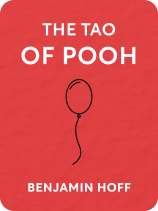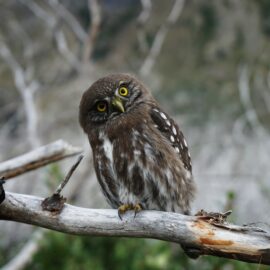

This article is an excerpt from the Shortform book guide to "The Tao of Pooh" by Benjamin Hoff. Shortform has the world's best summaries and analyses of books you should be reading.
Like this article? Sign up for a free trial here .
What are the main Tao principles? How does The Tao of Pooh illustrate each of these Lao Tzu principles with examples from Pooh?
There are six Tao principles. In The Tao of Pooh, Benjamin Hoff shows how Pooh represents each of these ideas.
Keep reading to better understand the six Tao principles in the context of Pooh.
The Six Tao Principles
The Tao of Pooh uses the characters from the stories of Winnie the Pooh to exemplify the Lao Tzu principles and teachings. Taoism is an ancient Chinese philosophy that focuses on the natural order of the universe as a guide for living, known as The Way. In Taoism, there are no preconceived notions about how life should be and no manipulation of the world to force it into what you want to happen. In the everyday world, people often use knowledge and cleverness to explain and justify behavior, rather than paying attention to the ebb and flow of the power that lives within everything. By giving your mind over to the power held within you and nature, you can find contentment and joy in simply living.
Six principles guide a Taoist life, and many elements from the stories of Pooh articulate the concepts held within them.
Principle 1
The first of the Tao principles is the concept of P’u (pronounced like Pooh), which says that things in their original state carry their own natural power. This concept is represented as the “Uncarved Block” and is a significant principle of Taoism. Pooh is the epitome of P’u because his simple-minded nature allows him to move through life and accomplish things without trying. He doesn’t know enough to question life or manipulate the world around him. His desires are simple; therefore, he lives simply.
Pooh illustrates two principles of the Uncarved Block: 1) a willingness to be spontaneous and the ability to be successful in those spontaneous endeavors and 2) the state of accepting things for what they are.
Principle 2
Cottleston Pie is a song sung by Pooh that expresses the second of the Lao Tzu principles. This is known as Inner Nature in Taoism. Inner Nature is the thing existing inside everything that makes it unique. The Cottleston Pie Principle has the following three doctrines:
1. Allow things to be what they are.
2. Everyone has limitations.
3. Some things cannot be known.
Principle 3
Wu Wei, or the Pooh Way, is one of the fundamental elements of Taoism and most appropriately describes the habits of Pooh. Roughly translated, this principle means “without acting” or acting without expending energy or struggle. Think of Wu Wei as water in a stream naturally gliding over or around obstacles in its way.
Wu Wei occurs when you acknowledge your Inner Nature and work with the rhythm of life. You expend minimal energy and experience no mistakes because nature does not make mistakes. Mistakes happen when you use your knowledge to interfere with the natural path laid before you.
Principle 4
If the Pooh Way is the way of inaction, then the opposite behavior would be overaction. In the world of Pooh, a person who is always moving, always searching for something they don’t have or a way to get more is called a “Bisy Backson,” which translates to “Busy, Back Soon!” A Bisy Backson is someone who is never at peace or content. They’re the ones pacing the floor, fidgeting, or rattling the change in their pockets. They must always be exerting the full capacity of their energy and feel like there’s never enough time.
In this frantic and unsatisfied place, the natural rhythm of life is overshadowed. There is no happiness or pride because the search for what’s just out of reach will never end. And when you don’t get what you want or what you get doesn’t feel like enough, you will blame the world instead of your inability to listen to it. If you want to be healthy, calm, and happy, do the opposite of the Bisy Backson.
Principle 5
The Tiddely Pom Principle, named after one of Pooh’s songs, is similar to the idea of the “Snowball Effect.” It relates to taking the first step of believing in yourself to allow the natural momentum of life to build toward happiness and contentment.
We all have something special and useful that we can offer the world. Often, we require some outward result or someone else to show us what our specialness is. But if you want to be the architect of your own life, you must find a way to believe in your power and learn how to wield it. You can use your gifts to make life work for you, rather than striving to be like others or waiting for fate to deliver what you want.
Principle 6
In Taoism, nothing equals something, and what we actually think of as something is nothing. But this is the final one of the Tao principles. Taoists call this T’ai Hsu, or “The Great Nothing,” which represents being able to see what’s in front of you when you’re not busy looking for something else. This idea is also known as the empty mind.
When the mind is full, there is no room for what simply is to exist. A full mind cannot hear or see clearly because knowledge and cleverness divert your focus to unnecessary aspects of things. You seek more than what is actually there or what needs to be there, which leads you down a path away from truth. Think of a bird singing. An empty mind hears the bird and enjoys the beautiful sound. A full mind will try to determine what kind of bird it is. Knowledge and cleverness will seek a way to validate the song, rather than simply allow it to exist.

———End of Preview———
Like what you just read? Read the rest of the world's best book summary and analysis of Benjamin Hoff's "The Tao of Pooh" at Shortform .
Here's what you'll find in our full The Tao of Pooh summary :
- How Winnie-the-Pooh perfectly models the principles of Taoism
- The 6 principles of Taoism reflected in Pooh's adventures
- How to become Winnie-the-Pooh and unlock a magic inside of you






